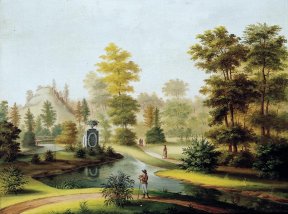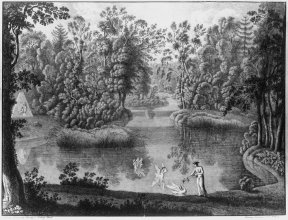... Reichsfreiherr* Edzard Mauritz zu Inn- und Knyphausen (Earl from 1816 onwards) decided to transform the representative Baroque garden with its different parts -- originally designed in the Dutch architectural style, but long-neglected -- into a naturally-formed, integrated landscape. He planted new foreign trees and shrubbery, dug canals and other streams and erected earth banks. He later added monuments and sculpted figures, so that the park gradually came to express his personal values and sentiments according to his experiences. We can see this in structures such as the stone pyramid in memory of his mother and his first wife, the friendship temple that he dedicated to a good friend, as well as in the Caroline Island with the Caroline memorial, which he dedicated to his deceased first daughter.
Following his death, Edzard Mauritz zu Inn- und Knyphausen's children carried out very little structural change in the park. Yet alterations in its character did occur at that time, thanks to the extensive planting of rhododendrons and later azaleas, whose spectacular blossoms transformed the garden of quiet contemplation into a colourful, festive area.
(*German title of nobility freely translated to 'baron of the empire' or 'imperial baron')
The park continued to be cultivated as a monument steeped in history and picturesque natural space. Only in 1932 was it extensively redeveloped by Fürst Wilhelm Edzard zu Inn- und Knyphausen.
After 1945, his commitment focused largely on clearing war damage and reconstructing the castle after a fire in 1956.
Castle Park counts today as one of the largest and most beautiful in northern Germany. Its 30 hectares and several kilometres of walking trails offers everyone, young an old, an oasis for regeneration. It is one of the few preserved examples of early Romantic garden types combining art and history as an integrative way of life.
The variety of over 150 exotic and native plant species, together with the vast expanse of the enclosure, make for the park's charm. Here every visitor can find his or her own space and discover the park's beauty for themselves. To this day, many characteristics of historical design have remained intact, so that you can still admire them in the park. For example, the ornate, affectionately inscribed benches invite every visitor to a moment of repose.
















